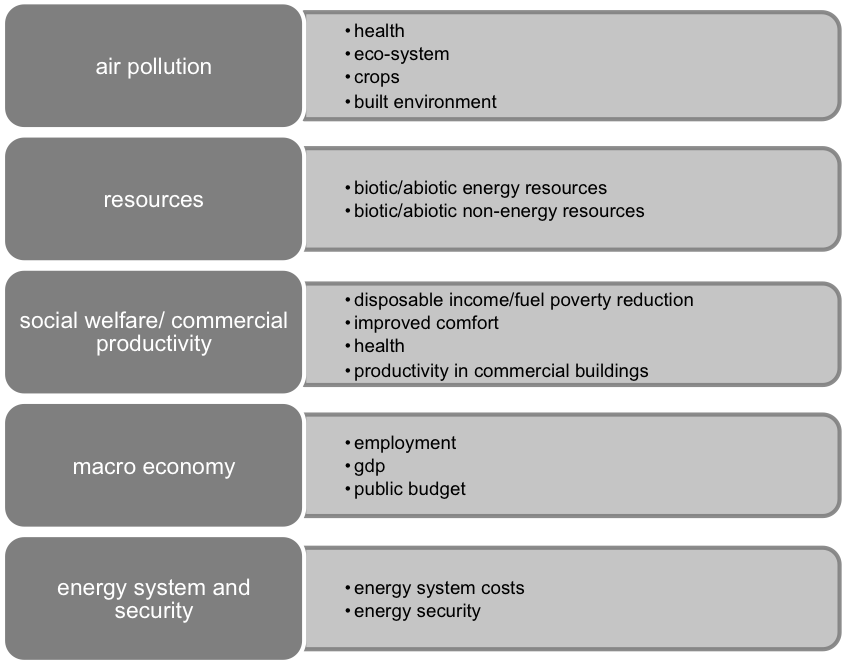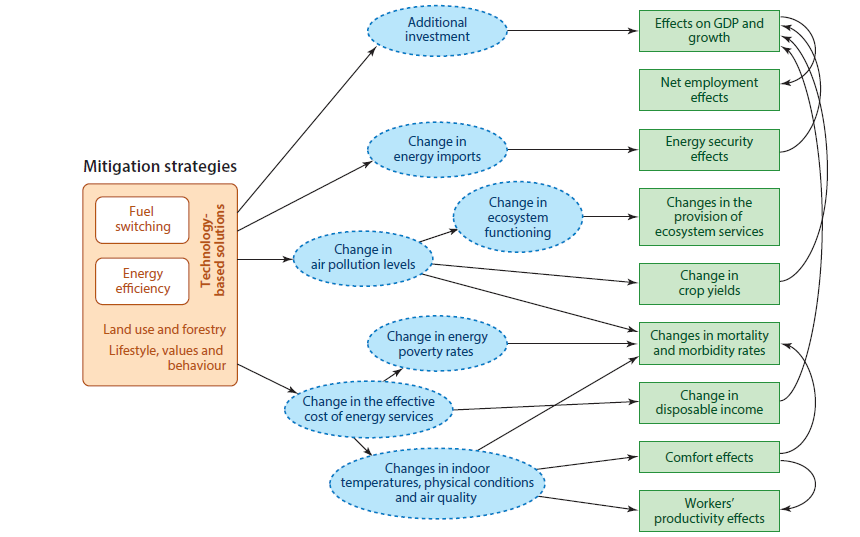Objectives
The improvement of energy efficiency in Europe aims at reducing overall energy consumption. However, this is not an end to itself but a mean to address major future energy challenges such as energy supply security, climate change, overcoming the economic crisis (see Energy Efficiency Directive 2012/27/EU). In addition, the implementation of energy efficiency measures can have other “non-energy” socio-economic and environmental effects such as effects on social welfare (by impacting e.g. fuel poverty, comfort levels etc.) or reduced pollution levels (which has further effects on health, the eco-system).
So far, existing research on the multiple benefits of energy efficiency addressing these effects is disperse and incomplete. Against this background, the overall objective of the project is to provide a comprehensive overview of the existing benefits in Europe for policy-makers, evaluators and the interested public and make research findings accessible. Figure 1 lists the most important co-benefits analysed within this project.
Figure 1: Multiple Benefits of energy efficiency improvements
Source: consortium presentation.
In this context, the project will
- refine existing methods and models, and where necessary develop new methods for the quantification and monetisation of selected benefits of energy efficiency improvements in different sectors (residential, commercial, industry, transport), and especially for their synthesis and integration into decision-making frameworks;
- apply these methods in order to derive (ranges of) values for the selected benefits of energy efficiency improvements;
- incorporate multiple benefits into decision-support frameworks for policy-making (e.g. cost-benefit analysis, energy efficiency cost curves or multicriteria analysis) and
- communicate research findings to policy-makers, evaluators and the public through easy-to-use tools, graphs and reports.
The target groups will benefit from project results in four ways:
- An online tool will be developed that helps the quantification of co-impacts for energy-efficiency measures in the particular context of the measure (country, sector, policy).
- An online communication tool will present the results graphically and provide options for the customisation/adaptation of the results to specific needs of the user. The aim is to show net costs of energy efficiency measures (including/excluding the multiple benefits).
- The derived default values of the elasticities and other values to allow an easy estimation of multiple benefits for concrete measures will be published open-access at the website for allowing further investigations of their implications for policy design or evaluation of existing policies by third parties.
- Policy-makers and researchers can include the methods and quantified values in their evaluation models, allowing a more precise assessment of the actual value of energy efficiency improvements, thus informing future decision-making for optimising energy efficiency policies in the horizon to 2030 and beyond.
One main challenge to be addressed are the partly interconnections and dependencies between existing between single benefits and benefit categories. Within the COMBI project, cause-impact interrelations will be identified, analysed and included in the quantification approaches. Figure 2 illustrates these interdependencies and suggests a first attempt to identify the impact pathways, endpoints, and thus key interactions as well as potential double counting.
Figure 2: Interrelations of multiple benefits of energy efficiency
Quantification of multiple benefits of energy efficiency
Benefits, costs and potentials: framework for decision-support
Project timeline
| Planned date | Deliverable | Milestone | Description | Status |
|---|---|---|---|---|
| July 2015 | D2.1 | General literature review | General review of quantification methodologies and challenges | available |
| July 2015 | D2.2 | Definition of action list | List of 30 end-use EE actions that will form the basis | available |
| September 2015 | D#.1 | Literature reviews on single multiple impacts | Separate literature reviews by impact categories on the state of research | available |
| September 2015 | D9.4 | Web-news and newsletter | Start of bi-annual project newsletter and continuous news-posting on the project website | |
| February 2017 | D2.4 | Summary of methodologies | Report giving an overview on the quantification methodologies applied within COMBI | |
| March 2017 | D#.4 | Methodology & results reports | Separate reports by impact categories on the quantification methodologies applied and research findings | |
| June 2017 | D2.7 | Final quantification report | Report containing the main research findings | |
| July 2017 | D8.2 | Full policy report | Report with in-depth conclusions for policy-makers derived from project findings | |
| July 2017 | D8.3 | Brochure | Summary brochure resuming the main findings | |
| July 2017 | D9.5 | Online tool | Interactive graphical data visualization tool placed on the home page of the project website |


